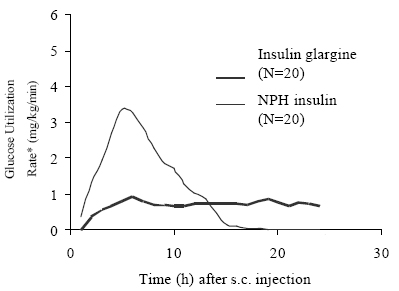Insulin glargine
| Clinical data | |
|---|---|
| ATC code | |
| Identifiers | |
| |
| CAS Number | |
| DrugBank | |
| E number | {{#property:P628}} |
| ECHA InfoCard | {{#property:P2566}}Lua error in Module:EditAtWikidata at line 36: attempt to index field 'wikibase' (a nil value). |
| Chemical and physical data | |
| Formula | C267H408N72O77S6 |
| Molar mass | 6063 g/mol |
|
WikiDoc Resources for Insulin glargine |
|
Articles |
|---|
|
Most recent articles on Insulin glargine Most cited articles on Insulin glargine |
|
Media |
|
Powerpoint slides on Insulin glargine |
|
Evidence Based Medicine |
|
Clinical Trials |
|
Ongoing Trials on Insulin glargine at Clinical Trials.gov Trial results on Insulin glargine Clinical Trials on Insulin glargine at Google
|
|
Guidelines / Policies / Govt |
|
US National Guidelines Clearinghouse on Insulin glargine NICE Guidance on Insulin glargine
|
|
Books |
|
News |
|
Commentary |
|
Definitions |
|
Patient Resources / Community |
|
Patient resources on Insulin glargine Discussion groups on Insulin glargine Patient Handouts on Insulin glargine Directions to Hospitals Treating Insulin glargine Risk calculators and risk factors for Insulin glargine
|
|
Healthcare Provider Resources |
|
Causes & Risk Factors for Insulin glargine |
|
Continuing Medical Education (CME) |
|
International |
|
|
|
Business |
|
Experimental / Informatics |
Editor-In-Chief: C. Michael Gibson, M.S., M.D. [1]
Insulin glargine, sold under the name Lantus, is a long-acting basal insulin analogue, usually given once or twice daily to help control the blood sugar level of those with diabetes. Its theoretical advantage is that it has a 24 hour duration of action, with a "peakless" profile. Thus, it more closely resembles the basal insulin secretion of the normal pancreatic beta cells. In type 2 diabetes and in combination with a short acting sulfonylurea (drugs which stimulate the pancreas to make more insulin), it can offer moderate control of serum glucose levels. In the absence of endogenous insulin (Type 1 diabetes or depleted type 2), Lantus needs the support of a fast acting insulin taken with food to reduce the effect of prandially derived glucose. It is post-prandial glucose elevation which more significantly affects HbA1c and thus determines the progression of the long-term complications of diabetes mellitus.

The peakless profile of Lantus also enables the dose to be relatively higher than standard NPH insulin. Because standard NPH is normally administered at night, its peak of action tends to coincide with the lower serum glucose levels associated with nocturnal metabolism. This can induce nocturnal hypoglycaemia. Lantus offers the benefit of a more consistent pharmacological dynamic without nocturnal hypoglycaemia. The result of this is a patient who feels more confident and more comfortable with a lower pre-bed and pre-breakfast capillary glucose level.
Lantus is formulated at pH 4, where it is completely water soluble. After subcutaneous injection, the body, at pH 7, slowly neutralizes the solution, causing insulin microcrystals to gradually precipitate from the insulin glargine solution, which then release insulin in bioloigically active form. This gradual process ensures that small amounts of Lantus are released into the body continuously, giving an almost peakless profile.
External links
- Pages with script errors
- E number from Wikidata
- ECHA InfoCard ID from Wikidata
- Infobox drug articles without a structure image
- Articles without EBI source
- Chemical pages without ChemSpiderID
- Articles without KEGG source
- Articles without InChI source
- Articles without UNII source
- Drugs with no legal status
- Articles containing unverified chemical infoboxes
- Diabetes
- Endocrinology